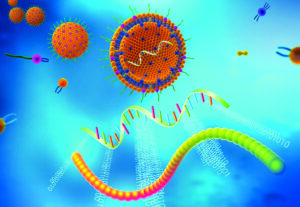Life Sciences
Complex lipids for sophisticated xRNA therapeutics 3rd November 2022
By Matthieu Giraud, PhD, Director, Global Peptides, Lipids & Carbohydrates Platforms CordenPharma International.

CordenPharma’s custom and standard lipids enable pharma to encapsulate advanced xRNA therapeutics.
One of the more popular enabling technologies in pharma development today are lipids and Lipid NanoParticles (LNPs). The recent success of mRNA vaccines is partly due to innovation in LNP delivery systems. These systems work because, not only do they express the mRNA-encoded immunogen after intramuscular injection, but they also play a key role as adjuvants and in vaccine reactogenicity.
Robust platforms for development, lipids and LNPs have become increasingly complex. This, in turn, is driving innovation by chemists and process engineers seeking to introduce sustainable, cost-efficient ways to produce these critical drug substances at scales suitable to development and commercialisation needs.1
Under the microscope
LNPs are liposome-like structures especially geared towards encapsulating a broad variety of genetic payloads, primarily nucleic acids (DNA-RNA based). Recent innovation in advanced RNA (xRNA) based therapeutics (mRNA, siRNA, saRNA, microRNA, and similar) is also attracting significant interest and investment in developing the technology’s therapeutic potential and disease-fighting impact. They are also under evaluation for the administration of the genome‐editing system Clustered Regularly Interspaced Palindromic Repeats (CRISPR)/Cas9.
LNPs are generally composed of cationic lipids, along with other lipid ingredients. Cationic lipids are critical to the self-assembly process of the particle, the ability of the particle to be taken up into cells and the escape of the RNA from the endosome. It is the functional cationic lipid component of the drug product that, when incorporated in lipid nanoparticles, helps regulate the endosomal release of the RNA. LNPs and Liposomes are similar in design, but different in composition and function. Both offer excellent attributes as drug delivery vehicles, effectively transporting actives in an outer layer of lipids.
Typically, other lipid ingredients for LNPs include neutral phospholipid molecules belonging to the phosphatidylcholine (PC) class and sterols, such as cholesterol. Another common lipid ingredient is PEGylated phospholipid—a polyethylene glycol (PEG) polymer covalently attached to the head-group of a phospholipid. PEG-lipids seem to prevent the activation of immune response (opsonisation) and improve stability of the LNPs.
The primary function of the PEGylated lipid is to form a protective hydrophilic layer that sterically stabilises the LNP, which contributes to storage stability, reduces non-specific binding to proteins, and prolongs the circulation time after in vivo administration. As higher PEG content can reduce cellular uptake and interaction with the endosomal membrane, PEG content is controlled.
Cholesterol, which stabilises LNP structures and facilitates endosome escape, comes from both synthetic-derived and animal sources. Non-animal origin cholesterol is emerging as the preferred option because its synthesis starts from plant material, which is then chemically converted into the final cholesterol to avoid any potential sources of animal-based contamination. CordenPharma offers a variety of standard lipids ideal for LNP formulation, including BotaniChol®, a non-animal origin cholesterol that helps stabilise LNP structures and facilitates endosome escape.
Advanced rapid mixing technology
Over the last decade, custom lipid synthesis has become better understood, demonstrating efficacy when delivering advanced complex mRNA therapeutics, including recent successes from Moderna and Pfizer BioNTech.
As lipid manufacturing and LNP formulation continues to develop, CDMOs like CordenPharma are driving new efficiency, quality and yield by leveraging innovative rapid mixing approaches for the LNP formulation of xRNA sterile injectable drug products. In this regard, two highly effective technology platforms have emerged: Microfluidic and Jet-Impingement.
Microfluidic technology controls the flow of two different solutions (water-based and lipid-based), then mixes them to deliver small, uniform particles capable of sterile formulation for proper introduction into the human body. Two commonly applied microfluidic mixing methods include Microfluidic Hydrodynamic Focusing (MHF) and Staggered Herringbone Micromixing (SHM). These methods introduce efficiencies at smaller scales, so are often used in early development and for clinical supply.
Jet-impingement technology accomplishes its function using a modified T-Junction design and increased pressure. Inherently, jet-impingement technology is more sustainable and especially suited to accommodate larger-scale LNP formulation and manufacturing because it can scale efficiently to increase throughput and yield.
Because rapid-mixing methods are currently being applied to emerging nucleic acid therapeutics like single guide RNA (sgRNA), the development of LNPs encapsulating these RNA types makes it clear that formulations are not interchangeable and need to be optimised for each type of nucleic acid payload. Early success has been shown for LNPs encapsulating mRNA with applications in single-dose vaccines for influenza and similar viruses for example.
Eco-efficient analytic techniques
High-grade complex lipids play an increasingly significant role in today’s xRNA pharmaceutical development landscape. The use of Supercritical Fluid Chromatography (SFC) technology to separate compounds is proving to be a cost-effective and highly efficient way to purify lipids and similar pharmaceutical drug substances.
Manufacturing of highly pure lipids requires unique capabilities, complex production processes and extensive resources to accomplish. Because SFC uses reclaimed CO2, coupled with online carbon dioxide recycling, it is more sustainable and resource-efficient. The benefit of SFC technology is the fact that it does not use organic solvents, is faster and directly recycles 95% of the CO2 used. As development continues, it is sure to highlight the role LNPs and liposomes play in unlocking the therapeutic potential of nucleic-acid-based therapeutics.
Lipids innovation
To support development and production of liposomal drugs, CordenPharma offers synthetic lipid process development, scale-up and large-scale custom manufacturing, as well as a catalogue of standard lipids. CordenPharma is also an early innovator of lipids, holding Drug Master Files (DMFs) on some of the industry’s most applied commercial technologies.
CordenPharma is focusing its operational and technical spending to give the industry increased access to smoother, faster development paths, including SFC technology to purify lipids. Its commitment to this exciting area of drug innovation is ongoing, and recent investments in facilities and teams are demonstrating to the industry how effective lipids and LNP technology is in delivering xRNA formulations.
- https://www.liposomes.ca/publications/2010s/Evers et al 2018 State-of-the-Art Design and Rapid-mixing Production Techniques of Lipid Nanoparticles for Nucleic Acid Delivery (pdf).


